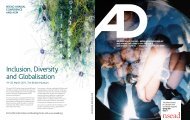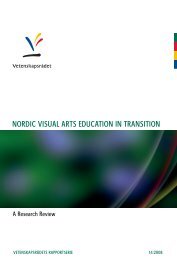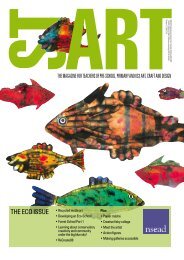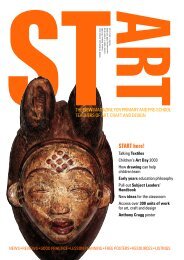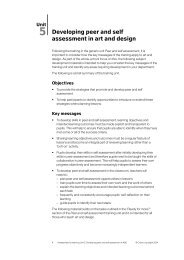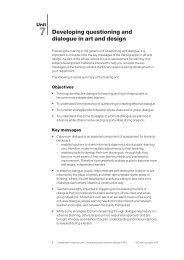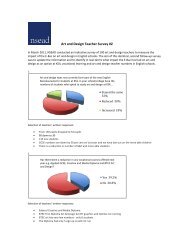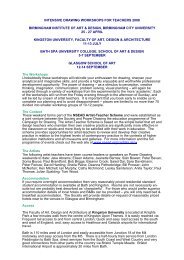Art and design exemplification standards file level 1 - The National ...
Art and design exemplification standards file level 1 - The National ...
Art and design exemplification standards file level 1 - The National ...
Create successful ePaper yourself
Turn your PDF publications into a flip-book with our unique Google optimized e-Paper software.
Planning the layout of the mural pieces<br />
Pupils held a mini plenary to decide how the pieces<br />
in the mural <strong>design</strong> would fit together. <strong>The</strong>y tested<br />
arrangements by laying out sections on the floor.<br />
<strong>The</strong>y also planned their next steps in the project.<br />
During this group work, the teacher observed that<br />
Pupil D saw her work as part of a whole. Pupil D<br />
also recognised that art can be decorative <strong>and</strong> a<br />
collaborative activity.<br />
Assessment commentary<br />
Working in a group, Pupil D had the opportunity to see her work as part of a whole. She has recognised that<br />
art can be decorative <strong>and</strong> a collaborative activity. She has evaluated the effectiveness of her own <strong>and</strong> other<br />
pupils’ work while emulating the collaborative nature of the methodology of other artists (the Boyle Family).<br />
Creating art, craft <strong>and</strong> <strong>design</strong>:<br />
Pupil D has worked effectively <strong>and</strong> developed confidence in using her technical knowledge <strong>and</strong> skills as<br />
well as the qualities of materials to realise her intentions. She has adapted photographs (by cropping<br />
<strong>and</strong> refining them) to create a drawing using the formal elements of composition, colour <strong>and</strong> texture.<br />
Next steps<br />
To progress, Pupil D needs to:<br />
■ refine her technical skills <strong>and</strong> use of formal elements to develop more varied <strong>and</strong> creative compositions<br />
in three-dimensional materials.<br />
Plaster cast<br />
Context<br />
<strong>The</strong>se activities were part of an extended project on l<strong>and</strong> art. <strong>The</strong> project took place over two terms.<br />
In the first term, pupils explored the environment around the school, considering their place within the local<br />
community. <strong>The</strong>y did research into l<strong>and</strong> art, took photographs of surfaces in their environment, produced<br />
drawings based on their photographs <strong>and</strong> created low-relief ceramic tiles based on these drawings. <strong>The</strong>y<br />
also worked together to take plaster casts from the tiles <strong>and</strong> put these casts into a low-relief mural, planning<br />
the layout of the tiles, assembling them <strong>and</strong> then installing the mural for exhibition in the school. A focus in<br />
this project was the approach <strong>and</strong> work of the Boyle Family, a group of artists who work collaboratively <strong>and</strong><br />
are best known for their three-dimensional casts of the surface of the earth.<br />
In this sequence of activities, pupils experimented with different tools to create a range of marks <strong>and</strong><br />
surfaces in clay. <strong>The</strong>y also used photographs they had taken as inspiration for creating different textures.<br />
<strong>The</strong>y were encouraged to take some risks <strong>and</strong> try to find as much information as possible about the marks<br />
that different tools would make. After providing instruction on safe practice with plaster, the teacher allocated<br />
sections of the <strong>design</strong> to pupils, who then took a plaster cast of their clay moulds. <strong>The</strong>y assembled the tiles<br />
in their mural, which was installed as part of a group art exhibit in the school.<br />
Page 47




